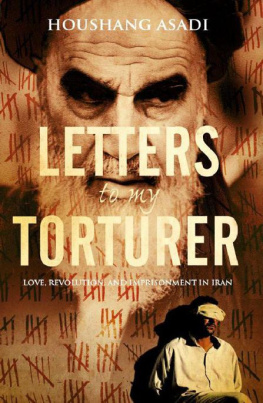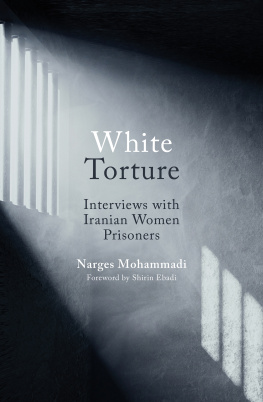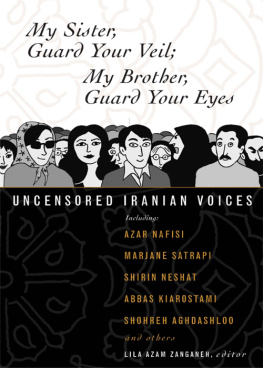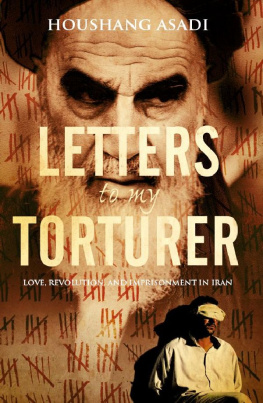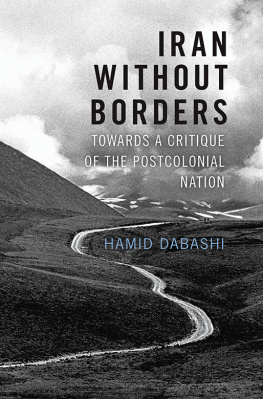Letters to My Torturer
A journalist, writer, and translator, Houshang Asadi was a member of both the Writers Association of Iran and the Iranian Journalists Syndicate, and the co-founder of the Association of Iranian Film Critics and Script Writers. Prior to the Islamic Revolution he served for many years as Deputy Editor at Kayhan, Irans largest daily news-paper, and was for twelve years the Editor-in-Chief of the countrys largest circulation film magazine, Gozaresh. He is the author of several novels, plays, and film scripts, and has translated into Persian important works by Gabriel Garcia Marquez, Mario Vargas Llosa, and T.S. Eliot.
In 1974 during the Shahs regime, Asadi was arrested along with other journalists and found himself sharing a tiny prison cell for 9 months with a young clergyman by the name of Ali Khamenei, currently Irans Supreme Spiritual Leader and the appointed successor to Ayatollah Khomeini. The two formed a close friendship that continued until events took a dramatic turn.
Shortly after the Islamic Revolution of 1979, and following the new governments crackdown on all opposition parties, Asadi was arrested once again. He was kept in solitary confinement for almost 2 years and severely tortured, until he falsely confessed to operating as a spy for the British and Russian governments. His sentence was death by hanging. In the end this was reduced to 15 years imprisonment. After 6 years he was freed and eventually escaped Iran in 2003. He now lives in exile in Paris with his wife, where he cofounded the influential Persian-language news website Rooz Online, on which he serves as a member of the editorial board.
To my wife, without whom this book,
and life, would be incomplete
LETTERS
to my
TORTURER
LOVE, REVOLUTION, AND IMPRISONMENT IN IRAN
HOUSHANG ASADI

Letters to My Torturer
First published by Oneworld Publications Ltd 2010
This ebook edition published by Oneworld Publications 2011
Copyright Houshang Asadi 2010
Translation copyright Nushin Arbabzadah 2010
The moral right of Houshang Asadi to be identified as the Author of this work has been asserted by him in accordance with the Copyright, Designs and Patents Act 1988
All rights reserved
Copyright under Berne Convention
A CIP record for this title is available
from the British Library
ISBN 9781780740317
Cover design by www.leonickolls.co.uk
Oneworld Publications Ltd
185 Banbury Road
Oxford OX2 7AR
England
Learn more about Oneworld. Join our mailing list to find out about our latest titles and special offers at:
www.oneworld-publications.com
Contents
Preface
Im talking about torture.
I was a young man longing for freedom, deeply patriotic, and in love with literature. I thought the world could be changed. I supported the Iranian Revolution in the fervent belief that green shoots of freedom would sprout up, no one would go hungry, and dictatorship would be consigned to dusty museums.
But suddenly I found myself in hell. In 1983, arrested in a government crackdown on opposition parties, I was assigned to the care of a man who was employed as my interrogator. I was helpless prey, caught in the trap of the brothers. In the Islamic Republic of Iran, brother is the generic title of all male believers, and each of the interrogators were therefore called brother and an assumed name. My whole existence lay in the hands of one such brother, Brother Hamid. In defending the holy government, Brother Hamid saw himself as Gods representative, with absolute control over every aspect of my life. Sleep, medication, food, even going to the toilet, were impossible without his permission. His motivation was hatred based on religious ideology, his tools were a whip and handcuffs. He saw me as a traitor, a spy, the embodiment of corruption and evil. Everything he assumed about me I had to confess to, and eventually I did, under the onslaught of brutal whippings, my feet raw and swollen from the lash, strung up from the ceiling of my cell by a rope for days and nights on end, deprived of sleep, of every human dignity, and in torment that my wife was being tortured too. If I needed anything, I had to bark like a dog. And whenever I barked, Brother Hamid laughed.
Brother Hamid transformed me from a young idealist to the lowest form of life on earth. After 682 days in solitary confinement, subjected to every deprivation, my confessions were used, in a show trial lasting just six minutes, to sentence me to fifteen years in prison. In the mass killings that were carried out by the government in the summer of 1988, I came very close to being hanged called up before another kangaroo court, I was forced to lie. Each prisoner was asked three questions: Are you a Muslim and say your prayers? Do you renounce your past? Do you believe in the Islamic Republic, and who is your point of reference. And I lied to all three questions. I said I hated my past and was devoted to Ayatollah Khomeini, and I was spared the rope. Eventually, after spending six years incarcerated in some of the most infamous jails in the Islamic Republic, I was freed to rejoin the mega-prison that is todays Iran. I escaped in 2003, and am now forced to live in exile.
Then one day, a few years ago, someone emailed me an image. He asked if I knew the man in the photo. I did. It was Brother Hamid, by this time one of Irans ambassadors. Staring into his eyes, I knew I needed to confront my torturer and the living nightmare that was his legacy to me. I searched through my scattered notes, written intermittently over the years since my release from prison, but they were filled with hatred and I no longer identified with them. I didnt wish to view the world, as my torturer had, in black and white terms. I didnt want to respond to the whip with the sword of my pen. No, now that I was the judge, I hated the idea of taking my revenge on him. Instead, I decided to write letters to him, to convey to him in some small way the intimate cruelty of those days and their aftermath.
Writing this book was a painful struggle. Every dawn as I started work on the manuscript, I would return to Brother Hamids hell. I would weep and write and the soles of my feet would throb. I even had a heart attack. Every fibre of my being protested, but I forced myself to keep going. I wanted to lay bare the life of a person under torture, and to describe the effect of that torture on the mind and body of a human being. In the process, I had to overcome my inner turmoil and remove every trace of hatred, line by line. I did my best to view the scene impartially and to be true to myself, as there is nothing more frightening to me than a victim of torture becoming a torturer himself. In the end, I began to see something of myself in my torturer, and found myself recognizing him as a human being too, as another person born in the same autocratic culture. And finally I gathered up my letters in this book, which I hope will eventually reach Brother Hamids hands, sooner or later. Perhaps he will recognise himself in these pages.
During my long years in prison, I realised that thousands of men and women, before me, alongside me, and after me, were tortured to death. I wish the story of torture and imprisonment could end with my story, and that of Brother Hamid. I wish the history of torture, which follows in the footsteps of the inquisitions of the Middle Ages, would end with the Islamic Republic of Iran. But even in recent times, from the valleys of Afghanistan to the prison camp of Guantnamo Bay, prisoners have been interrogated using techniques that, just fifty years earlier, the US military had condemned for eliciting false confessions. And we are all familiar with the sexual degradation and torture of Iraqi prisoners that was captured in chilling photographs, and appeared on our television screens and in newspapers around the world.
Next page
